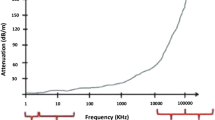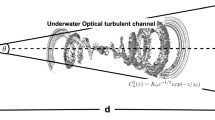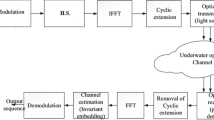Abstract
In this paper, the main aim is to study, simulate, and investigate a basic underwater optical wireless communication system in a direct line of sight (LoS) configuration. For this, we calculate total attenuation in ocean water, concerning depth-based chlorophyll concentration profile, in Scilab. The optical wavelength is 450 nm and depth varies from 0 to 250 m. Using these parameters, we found the optimum channel for all water types, comparing attenuation values at deep chlorophyll maximum (DCM). For the S9 chlorophyll profile, the DCM we found was 10 m, with attenuation at DCM as 7.391 m − 1. Then a simple system was designed in Optisystem, with blue light-emitting diode (LED) as the transmitter, for non-return-to-zero on–off keying (NRZ-OOK) modulation. The system performance was analyzed by visualizing the eye diagram at 50 Mbps and 10 m channel length. This study also emphasizes the selection of a suitable frequency of light that can traverse the channel with minimum path loss and a compatible bit rate.












Similar content being viewed by others
References
J. Giles and I. Bankman, Underwater optical communications systems. part 2: basic design considerations, MILCOM 2005 - 2005 IEEE Military Communications Conference, 1700–1705 3, (2005)
L.J. Johnson, R.J. Green, M.S. Leeson, Underwater optical wireless communications: depth dependent variations in attenuation. Appl. Opt. 52(33), 7867–7873 (2013)
A.N.Z. Rashed, H.A. Sharshar, “Performance evaluation of short range underwater optical wireless communications for different ocean water types. Wireless. Pers. Commun. 72(1), 693–708 (2013)
F. Abdalkarim Tahir, Open ocean underwater wireless optical communi- cation: chlorophyll and depth dependent variation in attenuation, Ph.D. dissertation, Universiti Tun Hussein Onn Malaysia, (2015).
J. Uitz, H. Claustre, A. Morel, S.B. Hooker, Vertical distribution of phytoplankton communities in open ocean: an assessment based on surface chlorophyll. J. Geophys. Res.: Oceans 111, C8 (2006)
T. Kameda, S. Matsumura, Chlorophyll biomass off sanriku, north- western pacific, estimated by ocean color and temperature scanner (octs) and a vertical distribution model. J. Oceanogr. 54(5), 509–516 (1998)
V.I. Haltrin, Chlorophyll-based model of seawater optical properties. Appl. Opt. 38(33), 6826–6832 (1999)
D. Stramski, A. Bricaud, A. Morel, Modeling the inherent optical properties of the ocean based on the detailed composition of the planktonic community. Appl. Opt. 40(18), 2929–2945 (2001)
J. Li, Y. Ma, Q. Zhou, B. Zhou, H. Wang, Monte Carlo study on pulse response of an underwater optical channel. Opt. Eng. 51(6), 066001 (2012)
R.C. Smith, K.S. Baker, Optical properties of the clearest natural waters (200–800 nm). Appl. Opt. 20(2), 177–184 (1981)
Z. Lee, K.L. Carder, R. Steward, T. Peacock, C. Davis, J. Patch, An empirical algorithm for light absorption by ocean water based on color. J. Geophys. Res.: Oceans 103(967–27), 978 (1998)
L. J. Johnson, The underwater optical channel, Dept.Eng.,Univ.Warwick, Coventry, UK, Tech. Rep, (2012)
R.H. Stavn, A.D. Weidemann, Optical modeling of clear ocean light fields: Raman scattering effects. Appl. Opt. 27(19), 4002–4011 (1988)
K. Shifrin, Physical optics of ocean water (Springer Science & Business Media, 1998)
C.T. Manimegalai, K. Sabitha Gauni, R.B. Kalimuthu, Design and analysis of turbo-coded DCM-OFDM ultra-wideband system with radio-over-fiber and wireless transmission in underwater communication. J. Opt. 49(1), 140–146 (2020). https://doi.org/10.1007/s12596-020-00603-9
R. H. Byrne, F. T. Mackenzie, and A. C. Duxbury, “Seawater,” (2018). [Online]. Available: https://www.britannica.com/science/seawater
C.D. Mobley, The optical properties of water. Handbook Opt. 1, 43–43 (1995)
S. Gauni, C.T. Manimegalai, K.M. Krishnan, V. Shreeram, V.V. Arvind, T.V. Srinivas, Design and analysis of co-operative acoustic and optical hybrid communication for underwater communication. Wireless Pers. Commun. 117(2), 561–75 (2021)
S. V. Kartalopoulos, Factors affecting the signal quality in optical data transmission and estimation method for ber and SNR, In: International Conference on Information Technology: Coding and Computing, 2004. Proceedings. ITCC , 2. IEEE, 615–619, (2004)
C.T. Manimegalai, K. Kalimuthu, S. Gauni, Toward integrating bidirectional multiband data and power transmission using double clad optical fibers for the next generation disaster resilient managing communication systems. Microwave Opt Technol Lett 64(4), 816–820 (2022). https://doi.org/10.1002/mop.33159
S.G. KalimuthuKrishnan, C.T. Manimegalai, V. Malsawmdawngliana, Ambient noise analysis in underwater wireless communication using laser diode. J Opt Laser Technol 114, 135–139 (2019)
Author information
Authors and Affiliations
Corresponding author
Additional information
Publisher's Note
Springer Nature remains neutral with regard to jurisdictional claims in published maps and institutional affiliations.
Rights and permissions
About this article
Cite this article
Manimegalai, C.T., Bhatta, H., Thakur, H. et al. Channel modeling for UWOC: a simulation approach. J Opt 51, 810–818 (2022). https://doi.org/10.1007/s12596-022-00854-8
Received:
Accepted:
Published:
Issue Date:
DOI: https://doi.org/10.1007/s12596-022-00854-8




